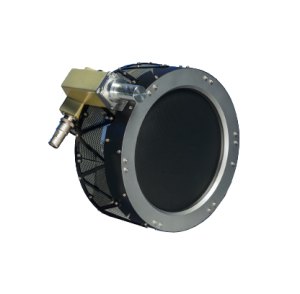The First European Plug and Play
Gridded Ion Engine Standardised Electric Propulsion Platform
Gridded Ion Engine Propulsion System
...to boost Europe’s competitiveness in the global satellite market.
Why Electric Propulsion?
Electric propulsion offers major improvements in over chemical propulsion systems.
Fuel Efficiency
Electric propulsion offers major improvements in fuel efficiency, enabling dramatic weight and volume savings which leads to significantly lower launch costs.
Higher Revenues for Operators
Due to the increase in payload that electric propulsion facilitates by its gain in weight and volume.
State-of-the-art
European gridded ion engine will give Europe the ability to not only compete but also take a lead in this growing worldwide market.
Why Gridded ion engine?
Compared to the often-used conventional ion engines, like Hall-Effect-Thrusters, Gridded Ion Engines bring a couple of advantages.

Highest Efficiency
Where HET is ceiling at an ISP of about 1800s a GIE can easily be brought to specific impulses above 3000s and higher and have thus the highest efficiency in the medium power range.
Lowest Plume Divergence
Enabling both the outstanding efficiency of the propulsion system while reducing thruster-platform-interactions to a minimum a GIE´s plume divergence can attain less than 10°.
Capable and Adaptable Technology
By its very definition GIE allows a clear technical separation between ionisation on one hand and ion acceleration / thrust generation on the other. This not only helps to master the technology but also eases individual adaptation to customer specific operating requirements.
How it works?
1st step – Ionisation
Ion thrusters employ a variety of plasma generation techniques to ionize a large fraction of the propellant, e.g. with radio frequency.
2nd step – Thrust Generation
The ionized fraction of the propellant is accelerated in an electrostatic field of the grid system and extracted out of the thruster to create thrust.
3rd step - Neutralization
To avoid any electrostatic effects, the extracted positive ions are submitted to a parallel flow of (negative) electrons so a neutralisation is attained almost immediately.
What does it look like?
The Most Efficient Propulsion System Explained from inside-out.

Functions
- 1. Extracting and accelerating grids: to accelerate positive ions
- 2. Sputter Shield: to protect from excessive sputtering
- 3. EMC Housing: to hold all inner parts of the thruster (e.g. ioniser) and protect against mechanical and electromechanical loads
- 4. Neutralizer Hollow cathode: to generate negative electrons
- 5. Neutralizer: to ensure the constant supply in electrons

- 1. Grid Package
- 2. Ioniser / discharge chamber
- 3. RF Coil
- 4. Isolating Gas Inlet
FAQ’s
Gridded ion thrusters are part of the electrostatic electric propulsion thrusters. The ion thruster generate thrust in two steps. In the first step ion thrusters employ a variety of plasma generation techniques to ionize a large fraction of the propellant. In the second step the ionized fraction of the propellant is accelerated in an electrostatic field of the grid system. The ion acceleration in a grid system is the common feature of all gridded ion engines. An ion thruster consists of basically three components: the plasma generator, the accelerator grids, and the neutralizer cathode.
A geostationary orbit, geostationary Earth orbit or geosynchronous equatorial orbit (GEO) is a circular orbit 35,786 kilometres above the Earth’s equator and following the direction of the Earth’s rotation. An object in such an orbit has an orbital period equal to the Earth’s rotational period (one sidereal day) and thus appears motionless, at a fixed position in the sky, to ground observers.
Gridded ion thrusters are part of the electrostatic electric propulsion thrusters. The ion thruster generates thrust in two steps. In the first step, ion thrusters employ a variety of plasma generation techniques to ionize a large fraction of the propellant. In the second step, the ionized fraction of the propellant is accelerated in an electrostatic field of the grid system. The ion acceleration in a grid system is the common feature of all gridded ion engines. An ion thruster consists of basically three components: the plasma generator, the accelerator grids, and the neutralizer cathode.
A Low Earth orbit (LEO) is an orbit around Earth with an altitude between 160 kilometers, and 2,000 kilometers. Objects below approximately 160 kilometers will experience very rapid orbital decay and altitude loss.
Technology readiness levels (TRL) are a method of estimating technology maturity of Critical Technology Elements (CTE) of a program during the acquisition process. They are determined during a Technology Readiness Assessment (TRA) that examines program concepts, technology requirements, and demonstrated technology capabilities. TRL are based on a scale from 1 to 9 with 9 being the most mature technology.
Contact GIESEPP MP team
Fill the form to get in touch with a project communication manager who will forward your request or email to the competent person.
Consortium






GIESEPP MP team about the project
Our team is looking forward to approving the system with the key players in the community and proceeding to market with it.

and RIT2X thruster family

of GIESEPP-MP

maneger assistance

Senior Scientist, PhD,
laboratory management




